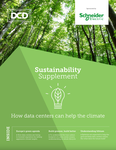Digital transformation is at the forefront of every industry, and data centers play a crucial role in supporting these initiatives. Digitalization can lead to more streamlined and efficient operations and can also be a more sustainable option for companies as they decrease their reliance on limited resources and eliminate waste. But digitalization and sustainability don’t always go hand in hand.
As companies use more digital resources, they’re also consuming more energy. The data center industry alone consumes about 200 TWh of electricity annually, according to a recent analysis from the International Energy Agency. This consumption, which is already astronomical, is only expected to rise.
Today, we better understand the strain data centers have on energy resources. As data centers’ demand for energy continues to rise, meeting that demand with climate-minded services will be essential to mitigate the industry’s environmental impacts. Below, I’ve outlined three ways data center managers can move forward with implementing sustainability strategies into their everyday practices.
Sustainability 101: Awareness
To begin a journey towards a more sustainable data center, leaders must first recognize their direct impact on the environment. Data centers demand high energy and sometimes high water use, contributing to a potentially large environmental footprint and increased possibility for waste.
As simple as it sounds, becoming aware of your usage is an important first step towards integrating sustainable practices into your business and building a foundation for setting future goals. Reviewing ppPower usage effectiveness (PUE), volumes of water and diesel consumed each month, financial results and up-time performance does a few things. It ensures these data points are accessible and begins to correlate improved energy and environmental performance with improved financial results. A reliance on limited resources, whether that be water or fossil fuels, also represents risk, so knowing these volumes can be informative in assessing risk embedded in operations.
Standards provide a framework to help perform these reviews and add an important element of rigor to the process, specifically ISO 50001 for Energy Management and 14001 for Environmental Management. These programs reinforce the continual improvement process of Plan, Do, Check and Act which creates long term, sustainable success towards goals.
While knowing your key environmental performance indicators internally is important, sharing this information publicly also brings real value. As transparency is the currency of trust, publishing data center performance plays an important role in gaining the confidence of new clients and in shaping public perception of the industry in general.
Setting goals: be bold
Once leaders have recognized the direct impact their data centers have on the environment and the communities in which they operate, and have begun communicating it internally, setting clear and measurable sustainability goals is a crucial next step. Gone is the mindset of needing to choose between operating profitably or sustainably. Organizations today are recognizing that improved ESG performance contributes to improved financial performance, and the investment community has taken note as well. While regulations set the minimum bar for sustainability compliance within data centers, industry pioneers are raising standards higher by pushing sustainability goals further with climate commitments becoming increasingly expected – internally and externally.
For example, while a goal of 100 percent renewable power was once a differentiator, we now recognize the potential to have even greater impact. This year Iron Mountain joined Google in setting public goals for 100% hourly matched carbon free energy from local resources. This will require new technologies and solutions that are only still emerging, yet will solidify a global movement to a fully decarbonized grid. Data centers can utilize their scale to demonstrate a market demand for these new solutions.
A data center must also set goals to optimize its water use and maximize energy efficiency. Operators may shy away from sharing power and water usage effectiveness results publicly, but there is value in demonstrating that these are priority performance measures of the business. Knowing (and sharing) this performance detail can lead to defining new facility standards for future construction, or possibly adopting a green building standard such as BREEAM, LEED or Green Globes. Iron Mountain has committed to BREEAM certification for all newly constructed colocation facilities.
Innovate and collaborate
Concerted efforts are necessary to see large scale environmental change and creating a greener data center landscape requires participation across the industry. In today’s interconnected, digitized world, it’s never been easier for industry leaders to meet and collaborate over data center innovations. To make an impact in the data center industry, business leaders need to collectively work together on setting and activating bold sustainability initiatives.
We are members of the Renewable Energy Buyers Alliance (REBA), which works across customers, suppliers, and policymakers to identify barriers to buying renewable energy and develop solutions that meet growing energy demands. REBA also focuses on increasing accessibility to renewable energy by contributing energy back into the grid. Companies can also consider signing the Corporate Colocation and Cloud Buyer’s Principles, created by BSR’s Future of Internet Power alliance group.
Just as collaboration within the industry plays an important role in accelerating environmental impact, so does collaboration with the local community in which you serve. There are often local organizations committed to preserving or enhancing important local resources. Developing a strong relationship with these organizations will garner support and can potentially influence other businesses to follow suit in their own sustainability journeys. Collectively, we all need to be mindful of the local impact data centers have and seek to make it as positive as possible.
Future proof your business
Sustainable business practices are on track to becoming standard business. Aside from being the best path towards preserving our environment, they’re often the best solution from a business standpoint. Not only is renewable energy environmentally and socially responsible, its costs are stable and provide long-term, reliable solutions. Bold environmental commitments are the future of building a green data center industry, and ultimately creating a sustainable digital transformation journey. I urge business leaders to work together and start implementing bold initiatives today.


